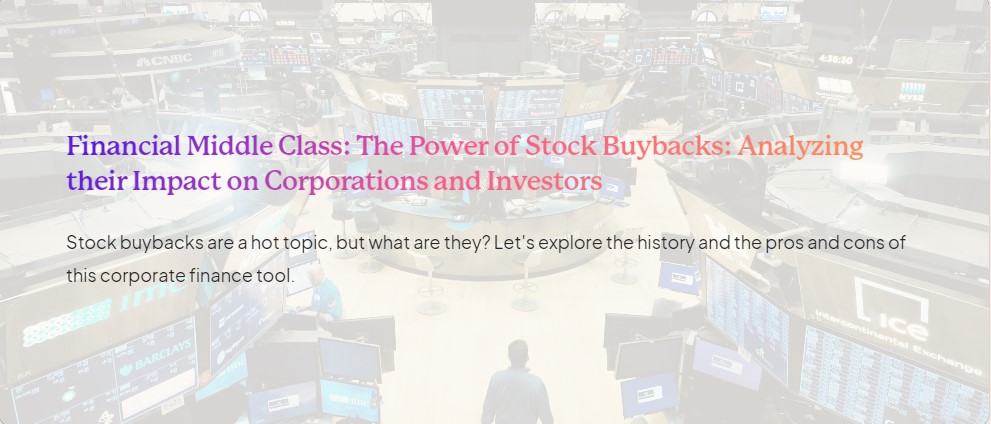The Power of Stock Buybacks: Analyzing their Impact on Corporations and Investors
Subtitle: A closer look at the influential practice shaping corporate finance strategies
In the dynamic realm of corporate finance, few strategies have generated as much attention and debate as stock buybacks.
As companies increasingly turn to this practice, which involves repurchasing their own shares from the open market, stock buybacks have become a significant force in shaping corporate finance strategies.
While praised by some as a catalyst for economic growth and innovation, stock buybacks also face criticism for their potential role in exacerbating income inequality and stifling long-term investment.
Understanding the complexities and implications of stock buybacks is crucial as the financial landscape evolves.
The Ascending Popularity of Stock Buybacks
Stock buybacks, known as share repurchases, have recently experienced significant traction.
According to S&P Dow Jones Indices data, companies in the S&P 500 spent a remarkable $806 billion on share repurchases in 2022, surpassing the previous record set in 2018.
This surge in buyback activity can be attributed to various factors, including robust corporate profits, low-interest rates, and tax reforms that incentivize the repatriation of overseas cash holdings.
Advocates Highlight Capital Allocation and Shareholder Returns
Proponents of stock buybacks argue that they serve as a powerful tool for capital allocation and have the potential to generate substantial returns for shareholders.
By reducing the number of outstanding shares, companies effectively boost earnings per share (EPS), increasing the value of each remaining share.
This can result in higher stock prices, benefiting both long-term investors and short-term traders. Advocates also contend that buybacks provide an efficient mechanism for deploying excess capital when alternative investment opportunities are limited.
Signaling Confidence and Instilling Market Sentiment
Furthermore, proponents argue that stock buybacks enable companies to demonstrate confidence in their own prospects. When management chooses to repurchase shares, they signal to the market that they believe the stock is undervalued and that future prospects warrant such a strategic move.
This act of confidence can instill trust and confidence in investors, potentially attracting additional investment and fostering a positive market sentiment.
Critics Raise Concerns about Priorities and Income Inequality
However, critics argue that stock buybacks primarily benefit shareholders and executives at the expense of other stakeholders.
Detractors maintain that companies should prioritize investments in research and development, capital expenditures, employee wages, and other avenues that promote long-term growth.
By diverting funds towards buybacks, corporations may neglect these critical areas, potentially hindering innovation and impeding economic development.
The issue of income inequality has also become intertwined with the buyback debate. Critics contend that stock buybacks inflate stock prices and disproportionately benefit wealthy shareholders, exacerbating societal wealth disparities.
Detractors argue that the funds used for buybacks could be better utilized to create jobs, increase wages, or support social initiatives that foster inclusive economic growth.
Regulatory Response and Implications
Regulatory bodies have begun to take notice in response to the heightened scrutiny.
For instance, the Securities and Exchange Commission (SEC) has proposed reforms to enhance disclosure requirements surrounding stock buybacks. These proposed regulations aim to give investors greater transparency regarding the timing, rationales, and impact of buybacks.
Additionally, lawmakers have proposed legislation restricting or imposing additional taxes on buybacks, raising questions about the potential consequences of such interventions on corporate behavior and market dynamics.
A Balanced Approach for Responsible Use
As investors and policymakers grapple with the implications of stock buybacks, it is vital to recognize that this strategy is not a one-size-fits-all solution.
The appropriateness and effectiveness of buybacks depend on various factors, including a company’s financial position, growth opportunities, and prevailing market conditions.
Striking a balance that considers the long-term interests of all stakeholders is crucial in ensuring the responsible and sustainable use of buybacks as a corporate finance strategy.
Conclusion: Navigating the Controversy
Stock buybacks have emerged as a prominent tool in corporate finance, evoking praise and criticism.
While advocates emphasize their potential to enhance shareholder value and signal confidence, detractors raise concerns about income inequality and the potential stifling of long-term investment.
As the debate continues, policymakers and market participants must strike the right balance, ensuring that buybacks are judiciously employed to benefit corporations and society.
